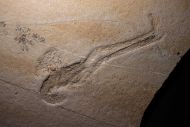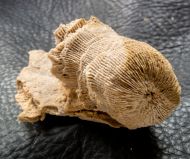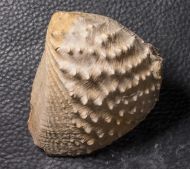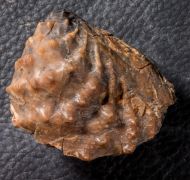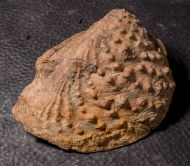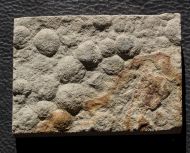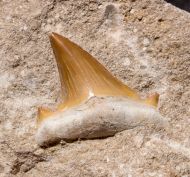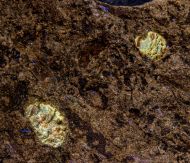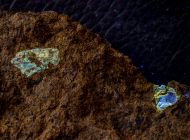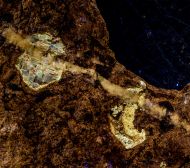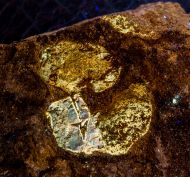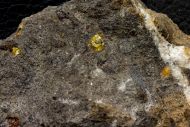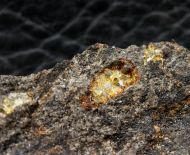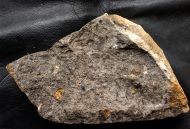Fossils for sale
Welcome back!
Other Fossils from all over the World
More sub categories:
Here is a good long-arm lobster of the species Mecochirus longimanatus from the Solnhofen limestone of Eichstätt. On or above its carapace is a small fossil sponge of the genus Codites.
Shipping time: 3-4 Days
90,00 EUR
7 % VAT incl.
This is a polished section of an exotic and decorative rock known as Bumble Bee Jasper. It is a carbonate microbialite that was partially formed under the influence of extremophile microorganisms.
Shipping time: 3-4 Days
65,00 EUR
19 % VAT incl.
This is a polished section of an exotic and decorative rock known as Bumble Bee Jasper. It is a carbonate microbialite that was partially formed under the influence of extremophile microorganisms.
Shipping time: 3-4 Days
46,95 EUR
19 % VAT incl.
This is a polished section of an exotic and decorative rock known as Bumble Bee Jasper. It is a carbonate microbialite that was partially formed under the influence of extremophile microorganisms.
Shipping time: 3-4 Days
55,00 EUR
19 % VAT incl.
Here is a beautiful and detailed specimen of a solitary coral of the species Montlivaltia obconica from late Jurassic Nattheim.
Shipping time: 3-4 Days
39,95 EUR
7 % VAT incl.
Here is a beautiful matrix piece of a fossil coral of the species Montlivaltia obconica from the Jura of Nattheim.
Shipping time: 3-4 Days
29,95 EUR
7 % VAT incl.
This detailed fossil Bivalve from the Jurassic of Portugal belongs to the species Myophorella (Clavotrigonia) lusitanica. This species is also still often identified as Trigonia lusitanica.
Shipping time: 3-4 Days
22,95 EUR
7 % VAT incl.
This double-valved fossilized shell from the Jurassic period of Portugal belongs to the species Myophorella (Clavotrigonia) lusitanica.
This species is also often referred to as Trigonia lusitanica.
This species is also often referred to as Trigonia lusitanica.
Shipping time: 3-4 Days
19,95 EUR
7 % VAT incl.
This fossilized bivalve shell from the Jurassic period of Portugal belongs to the species Myophorella (Clavotrigonia) lusitanica. It is often referred to by its alternate name, Trigonia lusitanica.
Shipping time: 3-4 Days
24,95 EUR
7 % VAT incl.
This is a large and interesting plate with numerous Ediacara fossils of the species Nemiana simplex.
Shipping time: 3-4 Days
225,00 EUR
7 % VAT incl.
Here is a Precambrian fossil plate with the Ediacaran fossil Nemiana simplex.
Shipping time: 3-4 Days
22,95 EUR
7 % VAT incl.
This is a Precambrian fossil plate with the Ediacaran fossil Nemiana simplex.
Shipping time: 3-4 Days
28,95 EUR
7 % VAT incl.
This is a fossil shark tooth from Morocco of the species Otodus obliquus on a nice matrix.
The fossil shark tooth presents itself nicely centered on a piece of authentic matrix and shows a good colour and preservation.
The fossil shark tooth presents itself nicely centered on a piece of authentic matrix and shows a good colour and preservation.
Shipping time: 3-4 Days
18,95 EUR
7 % VAT incl.
Plaffeiite is a rare alpine amber from the Paleocene, found in the Gurnigel Flysch of the Swiss Alps.
It shows strong UV fluorescence, contains no succinic acid, and derives from fossil conifers.
Due to tectonic fracturing, it's unsuitable for jewelry.
It shows strong UV fluorescence, contains no succinic acid, and derives from fossil conifers.
Due to tectonic fracturing, it's unsuitable for jewelry.
Shipping time: 3-4 Days
26,95 EUR
7 % VAT incl.
Plaffeiite is a rare alpine amber from the Paleocene, found in the Gurnigel Flysch of the Swiss Alps.
It shows strong UV fluorescence, contains no succinic acid, and derives from fossil conifers.
Due to tectonic fracturing, it's unsuitable for jewelry.
It shows strong UV fluorescence, contains no succinic acid, and derives from fossil conifers.
Due to tectonic fracturing, it's unsuitable for jewelry.
Shipping time: 3-4 Days
22,95 EUR
7 % VAT incl.
Plaffeiite is a rare alpine amber from the Paleocene, found in the Gurnigel Flysch of the Swiss Alps.
It shows strong UV fluorescence, contains no succinic acid, and derives from fossil conifers.
Due to tectonic fracturing, it's unsuitable for jewelry.
It shows strong UV fluorescence, contains no succinic acid, and derives from fossil conifers.
Due to tectonic fracturing, it's unsuitable for jewelry.
Shipping time: 3-4 Days
24,95 EUR
7 % VAT incl.
Plaffeiite is a rare alpine amber from the Paleocene, found in the Gurnigel Flysch of the Swiss Alps.
It shows strong UV fluorescence, contains no succinic acid, and derives from fossil conifers.
Due to tectonic fracturing, it's unsuitable for jewelry.
It shows strong UV fluorescence, contains no succinic acid, and derives from fossil conifers.
Due to tectonic fracturing, it's unsuitable for jewelry.
Shipping time: 3-4 Days
22,95 EUR
7 % VAT incl.
Plaffeiite is a rare alpine amber from the Paleocene, found in the Gurnigel Flysch of the Swiss Alps.
It shows strong UV fluorescence, contains no succinic acid, and derives from fossil conifers.
Due to tectonic fracturing, it's unsuitable for jewelry.
It shows strong UV fluorescence, contains no succinic acid, and derives from fossil conifers.
Due to tectonic fracturing, it's unsuitable for jewelry.
Shipping time: 3-4 Days
36,95 EUR
7 % VAT incl.
Plaffeiite is a rare alpine amber from the Paleocene, found in the Gurnigel Flysch of the Swiss Alps.
It shows strong UV fluorescence, contains no succinic acid, and derives from fossil conifers.
Due to tectonic fracturing, it's unsuitable for jewelry.
It shows strong UV fluorescence, contains no succinic acid, and derives from fossil conifers.
Due to tectonic fracturing, it's unsuitable for jewelry.
Shipping time: 3-4 Days
11,95 EUR
7 % VAT incl.
This is a large slab with several Swiss ambers, the largest plaffeiit on this piece measures approx. 20 x 13 mm.
Shipping time: 3-4 Days
65,00 EUR
7 % VAT incl.













